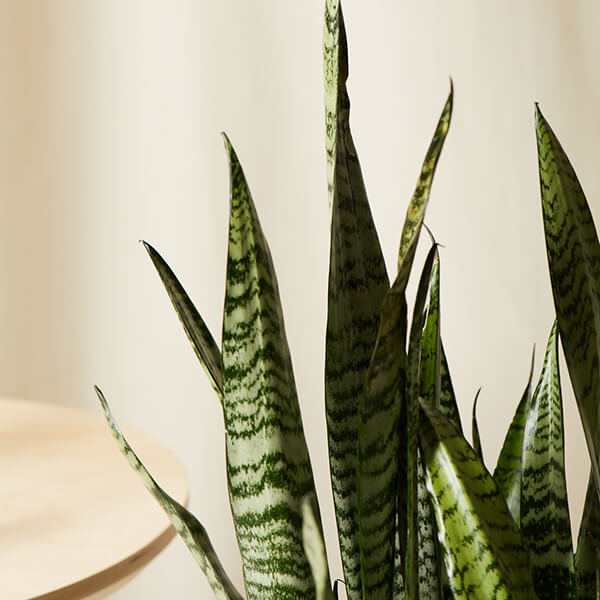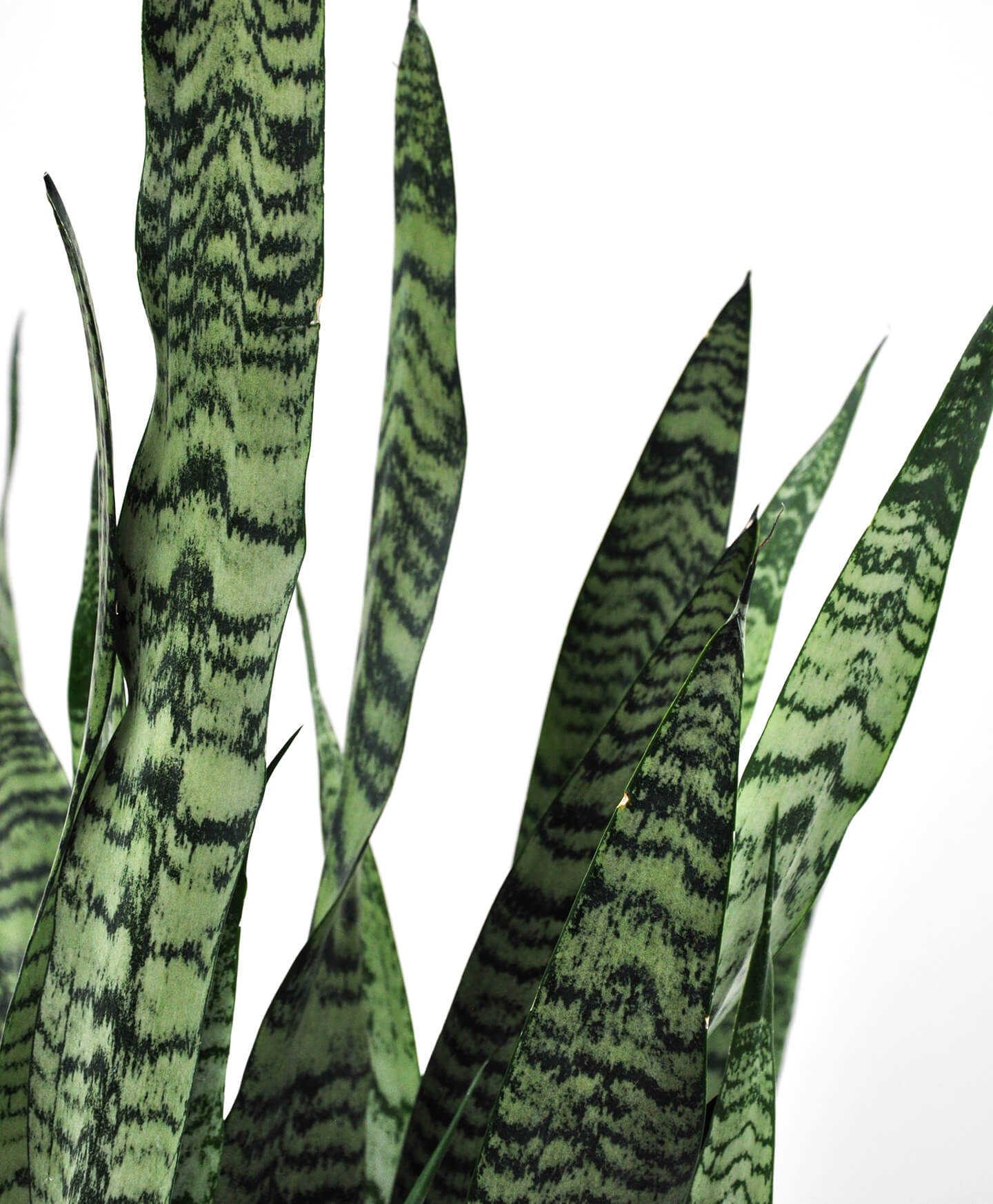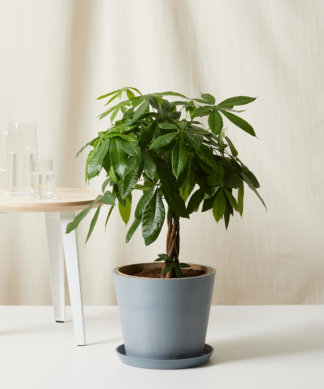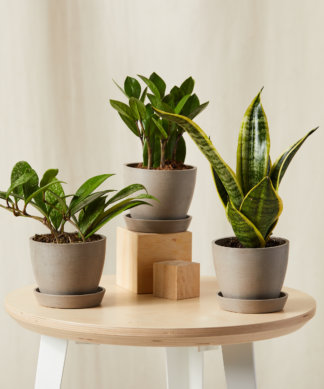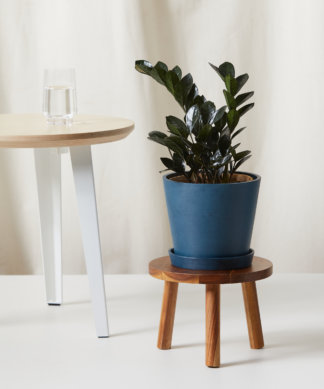How to care for your Sansevieria
Use these instructions to care for a Sansevieria. This guide will tell you how to water a Sansevieria; its light, temperature, humidity preferences and any additional care it might need to help it grow.
Samurai Sansevieria
Your Sansevieria is adaptable. It prefers medium to bright indirect light, but can also tolerate lower light as well as direct sun.
Water your Sansevieria only when the soil is completely dry. Water until liquid flows through the drainage hole at the bottom of the pot and discard any water that has accumulated in the saucer.
Your Sansevieria will thrive in temperatures of 55-85 degrees. However, they prefer temperatures on the warmer end of that spectrum.
Your Sansevieria prefers a dry environment. No need to mist.
Feed once every six months with a liquid fertilizer for indoor plants.
Your Sansevieria is mildly toxic to pets and humans. Typically, ingestion will cause mouth and stomach irritation and possible vomiting.
Your Sansevieria is an easy, hardy plant and doesn’t require any additional care.
Sansevieria
Your Snake Plant can tolerate any light level. The brighter the light, the faster it will grow. Always acclimate the plant over a few weeks if moving from indirect to direct light to avoid scorching the foliage.
Water only when the soil volume is 100% dry. It’s better to err on the dry side. Water thoroughly to encourage a healthy root system and discard any excess water in the saucer.
Your Sansevieria prefers a dry environment. No need to mist.
Temperatures ranging from 55-85°F are fine for your Snake Plant. Warmer temperatures encourage faster growth.
Feed once every six months with a liquid fertilizer for indoor plants.
Snake Plants are toxic to humans and pets if ingested.
Snake Plants reproduce by growing new plants (or ‘‘pups’’) near the base of the mother plant. To propagate your Snake Plant, carefully remove the leaves and stems of each pup once they become a few inches tall and plant them into a new pot.
Sansevieria Cylindrica
Does well in indirect bright light, but can maintain in low light.
Water when the soil volume is 100% dry. Water thoroughly until it flows out of the drainage hole. Discard any excess water from the tray after a few minutes.
Your Sansevieria Cylindrica does well in average household humidity.
Conditions ranging from 55-85°F are fine for your Sansevieria Cylindrica.
Feed once every six months with a liquid fertilizer for indoor plants.
The Sansevieria Cylindrica is toxic to pets and humans if ingested.
Keep your Sansevieria Cylindrica’s leaves clean by wiping them down with a damp cloth every couple of months. This removes dust to optimize photosynthesizing and discourages pests from taking up residence.
Sansevieria Golden Hahnii
Your Sansevieria is adaptable. It prefers medium to bright indirect light, but can also tolerate lower light as well as direct sun.
Water your Sansevieria only when the soil is completely dry. Water until liquid flows through the drainage hole at the bottom of the pot and discard any water that has accumulated in the saucer.
Your Sansevieria prefers a dry environment. No need to mist.
Your Sansevieria with thrive in average household temperatures of 55-85 degrees, but they prefer to be kept on the warmer end of the spectrum.
Feed once every six months with a liquid fertilizer for indoor plants.
Sansevierias are mildly toxic to pets and humans. Typically, ingestion will cause mouth and stomach irritation and possible vomiting.
Sansevierias are an easy, hardy plant and don’t require any additional care.
Sansevieria Lauren
Your Sansevieria is adaptable. It prefers medium to bright indirect light, but can also tolerate lower light as well as direct sun.
Water your Sansevieria only when the soil is completely dry. Water until liquid flows through the drainage hole at the bottom of the pot and discard any water that has accumulated in the saucer.
Your Sansevieria prefers a dry environment. No need to mist.
Conditions ranging from 55-85 degrees are fine for your Sansevieria.
Feed once every six months with a liquid fertilizer for indoor plants.
Sansevierias are mildly toxic to pets and humans. Typically, ingestion will cause mouth and stomach irritation and possible vomiting.
Sansevierias are an easy, hardy plant and don’t require any additional care.
Sansevieria Laurentii Superba
Your Sansevieria is adaptable. It prefers medium to bright indirect light, but can also tolerate lower light as well as direct sun.
Water your Sansevieria only when the soil is completely dry. Water until liquid flows through the drainage hole and discard any water that accumulates in the saucer.
Your Sansevieria prefers a dry environment. No need to mist.
Your Sansevieria prefers temperatures of 55°-85°F.
Feed once every six months with a general-purpose fertilizer for indoor plants. Never apply fertilizer to dry soil.
This plant is toxic to pets and humans if ingested.
Keep the leaves of your Sansevieria clean by wiping them down with a damp cloth every couple of months. Removing dust will optimize photosynthesis and discourage pests from taking up residence.
Sansevieria Moonshine
Your Sansevieria is adaptable. It prefers medium to bright indirect light, but can also tolerate lower light as well as direct sun.
Water your Sansevieria only when the soil is completely dry. Water until liquid flows through the drainage hole at the bottom of the pot and discard any water that has accumulated in the saucer.
Your Sansevieria prefers a dry environment. No need to mist.
Conditions ranging from 55-85 degrees are fine for the Sansevieria Moonshine, however, they prefer warmer temperatures.
Feed once every six months with a liquid fertilizer for indoor plants.
Your Sansevieria Moonshine is mildly toxic to pets and humans. Typically, ingestion will cause mouth and stomach irritation and possible vomiting.
Your Sansevieria Moonshine is an easy, hardy plant and doesn’t require any additional care.
Sansevieria Sayuri
Your Sansevieria is adaptable. It prefers medium to bright indirect light, but can also tolerate lower light as well as direct sun.
Water your Sansevieria only when the soil is completely dry. Water until liquid flows through the drainage hole at the bottom of the pot and discard any water that has accumulated in the saucer.
Your Sansevieria prefers a dry environment. No need to mist.
Conditions ranging from 55-85 degrees are fine for your Sansevieria.
Feed once every six months with a liquid fertilizer for indoor plants.
Sansevierias are mildly toxic to pets and humans. Typically, ingestion will cause mouth and stomach irritation and possible vomiting.
Keep your Sansevieria’s leaves clean by wiping them down with a damp cloth every couple of months. This removes dust to optimize photosynthesizing and discourages pests from taking up residence.
Sansevieria Zeylanica
Your Sansevieria is adaptable. It prefers medium to bright indirect light, but can also tolerate lower light as well as direct sun.
Water your Sansevieria only when the soil is completely dry. Water until liquid flows through the drainage hole and discard any water that accumulates in the saucer.
Your Sansevieria prefers a dry environment. No need to mist.
Your Sansevieria prefers temperatures of 55°-85°F.
Feed once every six months with a general-purpose fertilizer for indoor plants. Never apply fertilizer to dry soil.
This plant is toxic to pets and humans if ingested.
Keep the leaves of your Sansevieria clean by wiping them down with a damp cloth every couple of months. Removing dust will optimize photosynthesis and discourage pests from taking up residence.
Whale Fin Sansevieria
Your Whale Fin Sansevieria will grow more in indirect light but can maintain in lower light.
Water your Whale Fin Sansevieria when the soil is 100% dry. When all the way dry, water thoroughly until you see water flow out of the drainage hole. Discard any excess water after a few minutes.
Sansevierias do well in dry to average household humidity.
Conditions ranging from 55-85°F are fine for the Sansevieria, however, they prefer warmer temperatures.
Feed once every six months with a liquid fertilizer for indoor plants.
Toxic to humans and pets if ingested.
Dust regularly to deter pests and keep the unique striped pattern looking its best.






